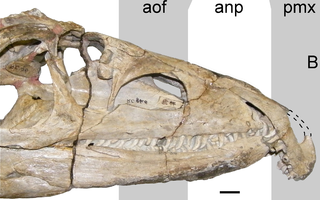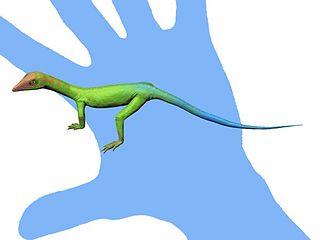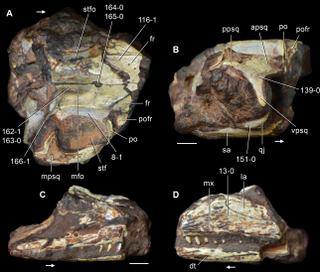
Dinocephalosaurus is a genus of long necked, aquatic protorosaur that inhabited the Triassic seas of China. The genus contains the type and only known species, D. orientalis, which was named by Chun Li in 2003. Unlike other long-necked protorosaurs, Dinocephalosaurus convergently evolved a long neck not through elongation of individual neck vertebrae, but through the addition of neck vertebrae that each had a moderate length. As indicated by phylogenetic analyses, it belonged in a separate lineage that also included at least its closest relative Pectodens, which was named the Dinocephalosauridae in 2021. Like tanystropheids, however, Dinocephalosaurus probably used its long neck to hunt, utilizing the fang-like teeth of its jaws to ensnare prey; proposals that it employed suction feeding have not been universally accepted. It was probably a marine animal by necessity, as suggested by the poorly-ossified and paddle-like limbs which would have prevented it from going ashore.

Archosauriformes is a clade of diapsid reptiles encompassing archosaurs and some of their close relatives. It was defined by Jacques Gauthier (1994) as the clade stemming from the last common ancestor of Proterosuchidae and Archosauria. Phil Senter (2005) defined it as the most exclusive clade containing Proterosuchus and Archosauria. Archosauriforms are a branch of archosauromorphs which originated in the Late Permian and persist to the present day as the two surviving archosaur groups: crocodilians and birds.

Archosauromorpha is a clade of diapsid reptiles containing all reptiles more closely related to archosaurs rather than lepidosaurs. Archosauromorphs first appeared during the late Middle Permian or Late Permian, though they became much more common and diverse during the Triassic period.

Tanystropheus is an extinct genus of archosauromorph reptile which lived during the Triassic Period in Europe, Asia, and North America. It is recognisable by its extremely elongated neck, longer than the torso and tail combined. The neck was composed of 13 vertebrae strengthened by extensive cervical ribs. Tanystropheus is one of the most well-described non-archosauriform archosauromorphs, known from numerous fossils, including nearly complete skeletons. Some species within the genus may have reached a total length of 6 meters (20 ft), making Tanystropheus the longest non-archosauriform archosauromorph as well. Tanystropheus is the namesake of the family Tanystropheidae, a clade collecting many long-necked Triassic archosauromorphs previously described as "protorosaurs" or "prolacertiforms".

Proterosuchus is an extinct genus of archosauriform reptiles that lived during the Early Triassic. It contains three valid species: the type species P. fergusi and the referred species P. alexanderi and P. goweri. All three species lived in what is now South Africa. The genus was named in 1903 by the South African paleontologist Robert Broom. The genus Chasmatosaurus is a junior synonym of Proterosuchus.

Tasmaniosaurus is an extinct genus of archosauromorph reptile known from the Knocklofty Formation of West Hobart, Tasmania, Australia. The type species is T. triassicus. This genus is notable not only due to being one of the most complete Australian Triassic reptiles known, but also due to being a very close relative of Archosauriformes. Once believed to be a proterosuchid, this taxon is now believed to have been intermediate between advanced non-archosauriform archosauromorphs such as Prolacerta, and basal archosauriforms such as Proterosuchus. Features traditionally used to define Archosauria and later Archosauriformes, such as the presence of an antorbital fenestra and serrated teeth, are now known to have evolved prior to those groups due to their presence in Tasmaniosaurus.

Doswelliidae is an extinct family of carnivorous archosauriform reptiles that lived in North America and Europe during the Middle to Late Triassic period. Long represented solely by the heavily-armored reptile Doswellia, the family's composition has expanded since 2011, although two supposed South American doswelliids were later redescribed as erpetosuchids. Doswelliids were not true archosaurs, but they were close relatives and some studies have considered them among the most derived non-archosaurian archosauriforms. They may have also been related to the Proterochampsidae, a South American family of crocodile-like archosauriforms.

Cosesaurus is a genus of archosauromorph reptiles likely belonging to the family Tanystropheidae. It is known from fossil imprints of a single small skeleton, MGB V1, which was found in Muschelkalk outcrops near the municipalities of Mont-ral and Alcover in Spain. These outcrops are dated to the Ladinian age of the middle Triassic about 242 to 237 million years ago. The specimen is stored at the Museu Martorell, which is now part of the Museu de Ciències Naturals de Barcelona. The poor preservation and likely juvenile nature of the specimen has led to the anatomy of Cosesaurus being misidentified by several different sources. For example, Paul Ellenberger claimed that it was an ancestor to birds in the 1970s, while David Peters claimed that it was a pterosaur ancestor in 2000. Both of these claims contrast with mainstream scientific theories on the origins of either group, and other paleontologists who study the specimen are unable to find the features which Ellenberger or Peters reported to be present. The Ellenberger and Peters hypotheses are thus considered fringe theories with questionable scientific soundness due to their low reproducibility. Mainstream hypotheses for the relations of Cosesaurus generally agree that it is a "protorosaur", specifically a tanystropheid closely related to long-necked reptiles such as Macrocnemus, Tanytrachelos, Tanystropheus, or Langobardisaurus.

Protorosauria is an extinct, likely paraphyletic group of basal archosauromorph reptiles from the latest Middle Permian to the end of the Late Triassic of Asia, Europe and North America. It was named by the English anatomist and paleontologist Thomas Henry Huxley in 1871 as an order, originally to solely contain Protorosaurus. Other names which were once considered equivalent to Protorosauria include Prolacertiformes and Prolacertilia.

Prolacerta is a genus of archosauromorph from the lower Triassic of South Africa and Antarctica. The only known species is Prolacerta broomi. The generic name Prolacerta is derived from Latin meaning “before lizard” and its species name broomi is in commemoration of the famous paleontologist Robert Broom, who discovered and studied many of the fossils found in rocks of the Karoo Supergroup. When first discovered, Prolacerta was considered to be ancestral to modern lizards, scientifically known as lacertilians. However, a study by Gow (1975) instead found that it shared more similarities with the lineage that would lead to archosaurs such as crocodilians and dinosaurs. Prolacerta is considered by modern paleontologists to be among the closest relatives of the Archosauriformes.

Pamelaria is an extinct genus of allokotosaurian archosauromorph reptile known from a single species, Pamelaria dolichotrachela, from the Middle Triassic of India. Pamelaria has sprawling legs, a long neck, and a pointed skull with nostrils positioned at the very tip of the snout. Among early archosauromorphs, Pamelaria is most similar to Prolacerta from the Early Triassic of South Africa and Antarctica. Both have been placed in the family Prolacertidae. Pamelaria, Prolacerta, and various other Permo-Triassic reptiles such as Protorosaurus and Tanystropheus have often been placed in a group of archosauromorphs called Protorosauria, which was regarded as one of the most basal group of archosauromorphs. However, more recent phylogenetic analyses indicate that Pamelaria and Prolacerta are more closely related to Archosauriformes than are Protorosaurus, Tanystropheus, and other protorosaurs, making Protorosauria a polyphyletic grouping.

Prolacertoides is an extinct genus of archosauromorph reptile from the Early Triassic of China, the type species being Prolacertoides jimusarensis. Prolacertoides means 'like Prolacerta', in reference to Prolacerta, another genus of archosauromorph which Prolacertoides was once believed to have been closely related to. Prolacertoides is known from a single partial skull, IVPP V3233, which was discovered in Xinjiang in northwestern China. The locality of its discovery belongs to the Cangfanggou Group of the Jiucaiyuan Formation, which is dated to the Induan age of the very early Triassic.

Eorasaurus is an extinct genus of archosauromorph reptile known from the middle Late Permian of Tatarstan, European Russia. It contains a single species, Eorasaurus olsoni. When originally described by Sennikov (1997), Eorasaurus was identified as an early archosauromorph and assigned to the family Protorosauridae, Ezcurra et al. (2014) and Ezcurra (2016) later reclassified Eorasaurus and placed it within the group Archosauriformes. Eorasaurus is based solely on scant fossil material from the neck region, and is thus considered an unstable taxon in phylogenetic analyses. If Eorasaurus is an archosauriform, it would be the oldest known member of the group and would pre-date the previous record holder.

Aenigmastropheus is an extinct genus of early archosauromorph reptiles known from the middle Late Permian Usili Formation of Songea District, southern Tanzania. It contains a single species, Aenigmastropheus parringtoni, known solely from UMZC T836, a partial postcranial skeleton of a mature individual. It was collected in 1933, and first described in 1956, as a "problematic reptile" due to its unique morphology. Therefore, a binomial name was erected for this specimen in 2014. Aenigmastropheus was probably fully terrestrial.

Teyujagua is an extinct genus of small, probably semi-aquatic archosauromorph reptile that lived in Brazil during the Early Triassic period. The genus contains the type and only known species, T. paradoxa. It is known from a well-preserved skull, and probably resembled a crocodile in appearance. It was an intermediary between the primitive archosauromorphs and the more advanced Archosauriformes, revealing the mosaic evolution of how the key features of the archosauriform skull were acquired. Teyujagua also provides additional support for a two-phase model of archosauriform radiation, with an initial diversification in the Permian followed by a second adaptive radiation in the Early Triassic.

Allokotosauria is a clade of early archosauromorph reptiles from the Middle to Late Triassic known from Asia, Africa, North America and Europe. Allokotosauria was first described and named when a new monophyletic grouping of specialized herbivorous archosauromorphs was recovered by Sterling J. Nesbitt, John J. Flynn, Adam C. Pritchard, J. Michael Parrish, Lovasoa Ranivoharimanana and André R. Wyss in 2015. The name Allokotosauria is derived from Greek meaning "strange reptiles" in reference to unexpected grouping of early archosauromorph with a high disparity of features typically associated with herbivory.

Ozimek is a genus of sharovipterygid archosauromorph reptile, known from Late Triassic deposits in Poland and closely related to the Kyrgyzstani Sharovipteryx. It contains one species, O. volans, named in 2016 by Jerzy Dzik and Tomasz Sulej. Like Sharovipteryx, Ozimek had long, slender limbs with the hindlimbs longer than the forelimbs; the hindlimbs likely supported gliding membranes as fossilized in Sharovipteryx. Another unusual characteristic was the shoulder girdle, where the massive coracoids formed a shield-like structure covering the bottom of the shoulder region that would have limited mobility. In other respects, such as its long neck, it was a typical member of the non-natural grouping Protorosauria. Phylogenetic analysis has indicated that it, possibly along with Sharovipteryx, may have been an unusual member of the protorosaur group Tanystropheidae, although further study of its anatomy is needed to resolve its precise relationships.

Pectodens is an extinct genus of archosauromorph reptile which lived during the Middle Triassic in China. The type and only species of the genus is P. zhenyuensis, named by Chun Li and colleagues in 2017. It was a member of the Archosauromorpha, specifically part of the unnatural grouping Protorosauria. However, an unusual combination of traits similar and dissimilar to other protorosaurs initially led to confusion over its evolutionary relationships. In 2021, it was placed in a newly-established group, Dinocephalosauridae, along with its closest relative Dinocephalosaurus.

Kadimakara is an extinct genus of early archosauromorph reptile from the Arcadia Formation of Queensland, Australia. It was seemingly a very close relative of Prolacerta, a carnivorous reptile which possessed a moderately long neck. The generic name Kadimakara references prehistoric creatures from Aboriginal myths which may have been inspired by ice-age megafauna. The specific name K. australiensis relates to the fact that it was found in Australia. Prolacerta and Kadimakara were closely related to the Archosauriformes, a successful group which includes archosaurs such as crocodilians, pterosaurs, and dinosaurs.
Boreopricea is an extinct genus of archosauromorph reptile from the Early Triassic of arctic Russia. It is known from a fairly complete skeleton discovered in a borehole on Kolguyev Island, though damage to the specimen and loss of certain bones has complicated study of the genus. Boreopricea shared many similarities with various other archosauromorphs, making its classification controversial. Various studies have considered it a close relative of Prolacerta, tanystropheids, both, or neither. Boreopricea is unique among early archosauromorphs due to possessing contact between the jugal and squamosal bones at the rear half of the skull.






















